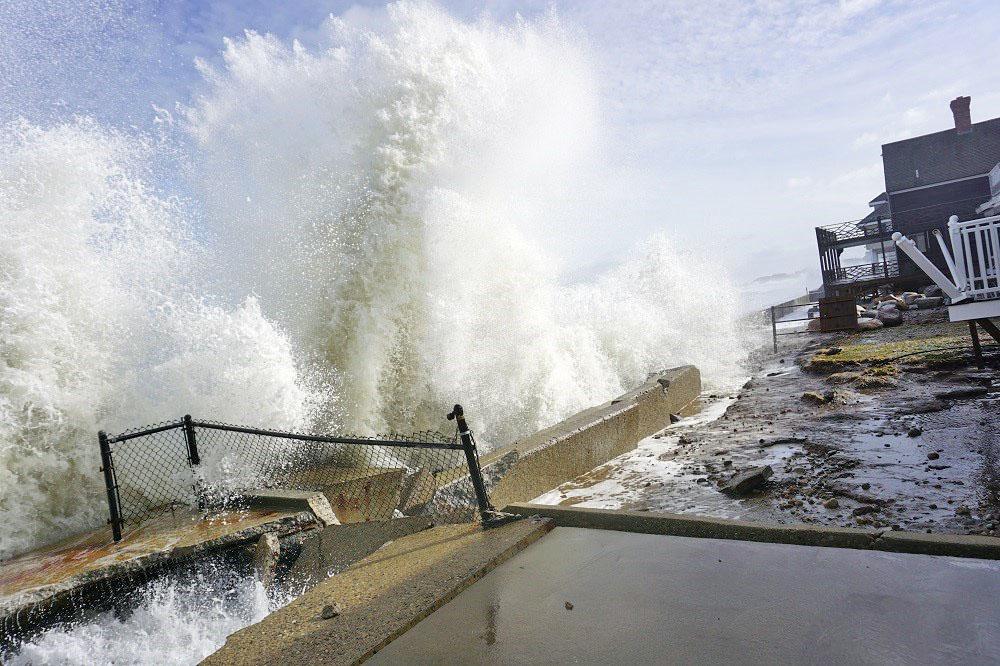Challenge
The town of Marshfield, Massachusetts, is a coastal community with rivers and wetlands. About 40% of the buildings in town are in Special Flood Hazard Areas along the coast. The town has experienced large flood events, including a seawall breach in 2015 during Winter Storm Juno. High risk and high flood insurance costs prompted town officials to better plan for disasters to help their residents.
Solution
Marshfield’s chosen solution was to use FEMA’s Community Rating System (CRS) program during the update of their single-jurisdiction hazard mitigation plan (HMP). The CRS helps communities reduce flood risk through mitigation, outreach and planning. When communities reduce their risks, the benefits include lower flood insurance rates for residents. Officials in Marshfield combined the planning process with CRS floodplain management activities. These activities have built momentum in Marshfield to reduce risk, especially from flooding, which is one of the coastal town’s main concerns.

Multiple public outreach efforts related to flood hazards have strengthened the community needs assessment and helped inform updates to the local mitigation plan. The public process for this update included an online community survey, which asked residents to list parts of the community (historical markers, community centers, etc.) that are important to them. This survey also asked community members how best to share and get information to them. The survey results helped the town prioritize flood-related outreach efforts required for CRS participation and updating the plan. In addition, each plan action was cross-referenced with its corresponding CRS action category (e.g., Preventative Measure, Property Protection, Structural Flood Control Project).
A major contributing factor to the success of these planning efforts is the town’s Program for Public Information (PPI), which is one of only four in New England. A committee of local staff and volunteers was established in 2018 to drive both CRS participation and planning efforts. Joy Duperault, the state’s National Flood Insurance Program coordinator, commented, “The town of Marshfield has been blessed with dedicated volunteers and staff who understand the value of the CRS program, and who have worked faithfully over the years to improve their rating with excellence in local activities. Their PPI is outstanding—truly a model for the rest of us!”. The CRS program requires at least half of the planning committee be members of the public, and a public meeting must be held in the first 2 months of the planning process. The program also requires yearly reports on the progress of projects and of public outreach efforts. The PPI committee goes beyond this requirement, meeting four times a year to review projects and planning progress. This has kept town staff and other community stakeholders focused on putting the plan into action.
The status of projects is recorded and updated regularly. Tracking progress locally helps the town succeed in actions identified in the FEMA-approved State Hazard Mitigation Plan and in climate adaptation programs. For example, some actions include applying for grants to fund town-wide beach restoration projects or elevating a bridge. Because of the PPI committee’s hard work, Marshfield has received a higher rating in the CRS program, giving homeowners additional discounts on their flood insurance premiums.

Key Takeaways
- Communities in areas with frequent flooding can use the CRS to reduce their risk and the flood insurance rates of NFIP policyholders.
- Floodplain management planning can be done alongside ongoing plan updates, meaning that the community prepares one plan that includes both mitigation planning and CRS requirements.
- Regular reviews of mitigation goals, actions and implementation help a community stay on track. Ongoing discussions can also determine when to apply for funding to complete bigger projects.
- Maintaining momentum and community engagement is critical for achieving success in implementation.
Related Documents and Links
The application window to apply for FEMA Hazard Mitigation Assistance grants is open through Jan. 29, 2021. To learn more about funding eligible projects, review the Flood Mitigation Assistance Program and the new pre-disaster mitigation program, Building Resilient Infrastructure and Communities. A FEMA-approved HMP is required for funding under these programs.
- Marshfield Multi-Hazard Mitigation Plan, 2018 (approved March 2018, expires March 2023).
- Program for Public Information, August 2018.
- FEMA Community Rating System.
- Marshfield, Massachusetts, Flood Insurance and Maps Information.


